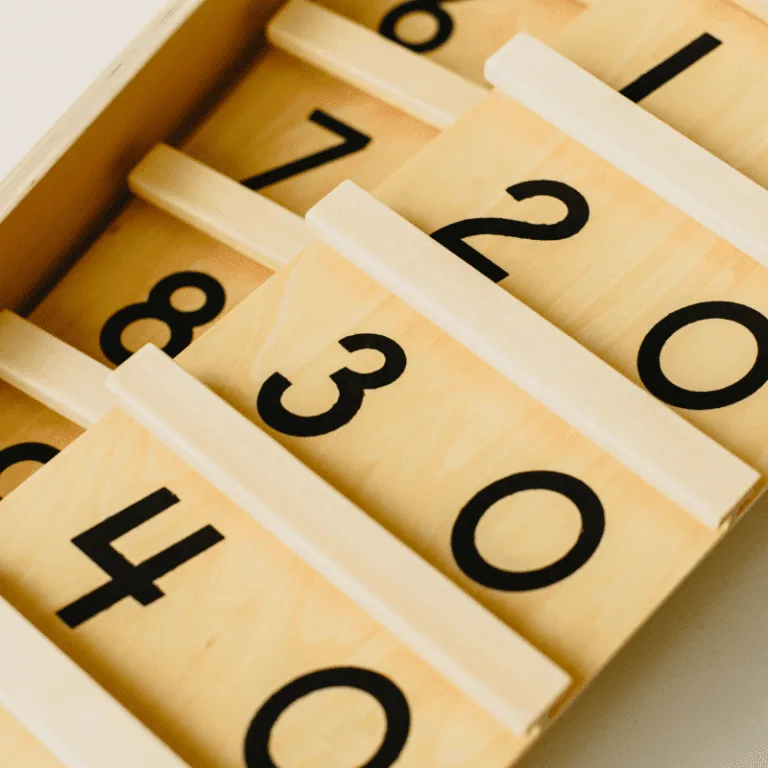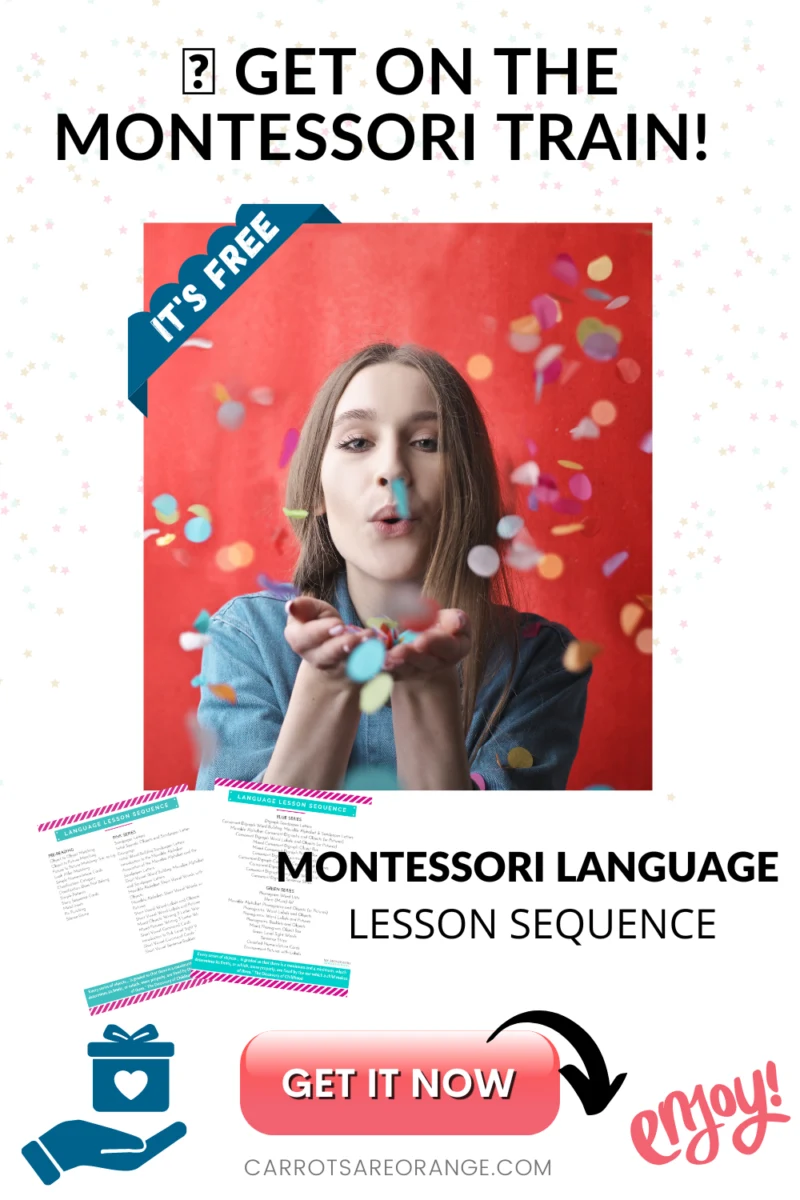I earn commissions from my affiliated links. Please see my disclosure policy for more details.
Montessori theory is a popular approach to early childhood education that many parents are curious about. But what is Montessori, exactly? And how can you tell if the Montessori curriculum is the right fit for your child?
This post will discuss everything you need to know about Montessori theory. Plus, we'll share tips for choosing the right educational environment for your little one. So whether you're just starting to explore your options or are narrowing down your list of potential schools, read on for all the details!
What is the Montessori Method of Teaching?
I hear this question often. So, I created a guide for those beginning your understanding of the Montessori meaning.
I hope this guide provides an overview of Montessori Philosophy & Theory based on the American Montessori Society's approach to the Montessori method of education created over 100 years ago.

The Montessori method of education centers on developing the child's whole self and allowing a child to lead that development. Respecting the child is at the core of this approach.
A Montessori environment is carefully planned and prepared to meet the child's needs. Montessori activities have a specific and well-thought-out approach.
The child has liberty within that environment to choose materials based on interest and ability. Every material has a lesson given by the directress or guide.
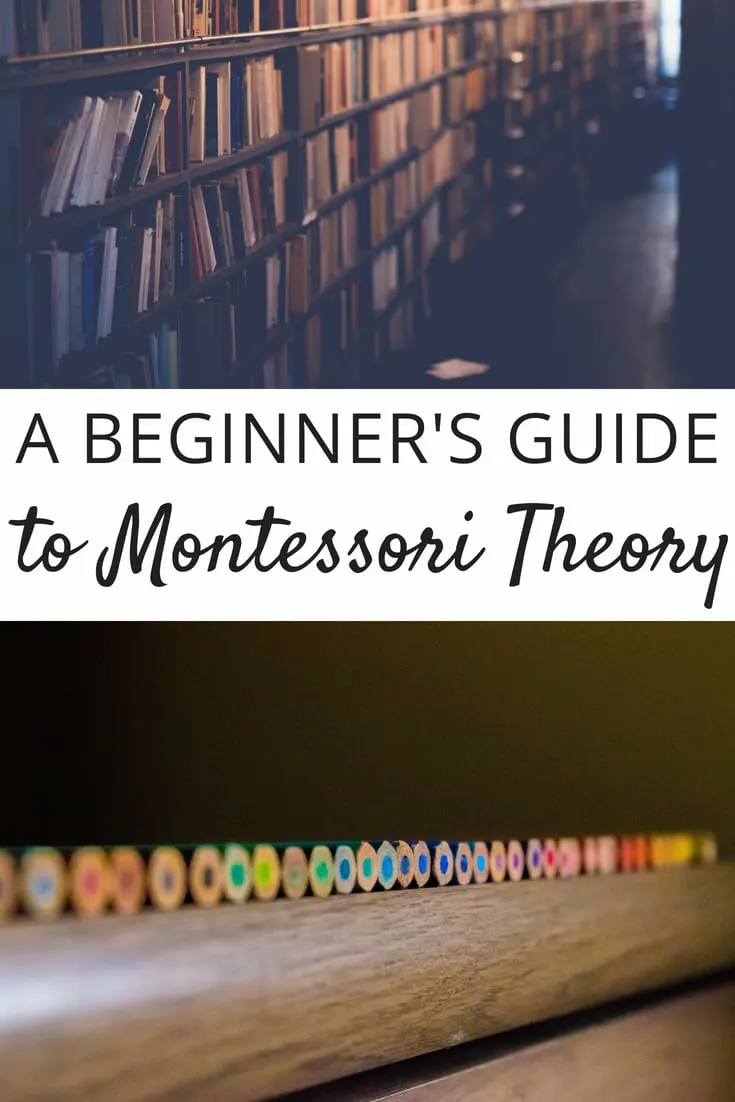
From birth through approximately age 6, the young child experiences a period of intense mental activity that allows her to “absorb” learning from her environment without conscious effort, naturally and spontaneously.
What Do Mean By The Absorbent Mind?
in 1949, Dr. Maria Montessori published a book called “The Absorbent Mind.” She believed strongly in this theory of child-centered development and centered much of her work on it.
Birth – 6 years old is subdivided into the subconscious and conscious periods and sensitive periods for order, language, movement, refinement of the senses, math, and manners.
Montessori Theory – Role of Parents & Teachers
Parents and teachers aid children but act as guides, observers, and careful preparers of the environment. By giving the child liberty to move about the classroom with a natural desire to learn, the child learns at his own pace of development.
Furthermore, he maintains an interest in the variety of materials available to him across subject areas and levels of difficulty.
Too often, adults interfere unnecessarily when the child needs guidance to help him stay within the parameters of his natural development.
If given the opportunity, children will demonstrate a level of focus and concentration in working with the materials that surprise most adults.

Montessori wrote extensively about the spiritual journey and self-awareness that a teacher must follow and experience to be effective.
My jaw dropped when I read that she views teachers as scientists needing to understand the psychology of children to understand a child's development.
That observation makes so much sense to me, yet I had never seen it written down. This fact alone drives the way an adult should teach and parent children.
Montessori Philosophy – Spiritual Preparation First, Lessons Later
Once the teacher trains on the method and prepares spiritually to direct a class, she focuses on giving lessons and introducing the child to the materials. From there, the child leads his learning experience with his own “hands” with “control of error” built into the works to enable auto-education.
The teacher observes the child and knows when to intervene to direct the child back to an activity that suits his development. If the child is not treating material properly, the teacher will redirect the child to end that work (perhaps he was not ready to complete that work) or to give another lesson.
The child learns respect through these experiences.
Prepared Environment
In addition to the holistic training she put forth with Montessori teachers, Maria implemented the Montessori method through a carefully prepared environment where there are ample opportunities for the child to develop at his or her own pace.
The environment should be a place that “nourishes the child” by not only meeting the needs for auto-education, which requires a child to develop at his own pace but also allowing the child’s unique personality and developmental path to reveal itself naturally.
It is important to note that the Montessori philosophy does not view the classroom as a replacement for life but as a means to reach “the potential life within him visible.” [Montessori: A Modern Approach]
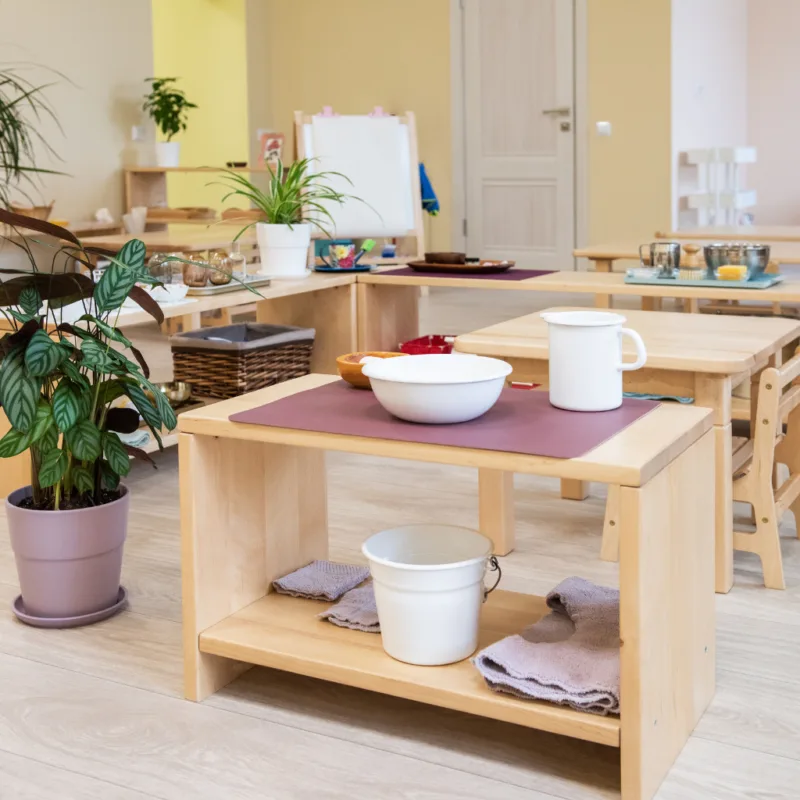
The teacher and the assistant carefully prepare the classroom environment for children ages 2.5-6. The mixed-age classroom is a critical aspect of the Montessori method.
Children develop at different paces. Mixed-age classrooms also provide built-in peer-to-peer teaching and role models for younger children. Older children take on the responsibility of demonstrating to younger children their knowledge.
The materials are of high quality and ascetically pleasing to the eye. They are simple and neat. There is a great sense of order in the presentation of the materials on the shelf and in the layout of the classroom in designated areas for Practical Life, Sensorial, Culture, Geography, Maths, and so on.
Every material in the Montessori classroom contains a “control of error,” the ability for the child to self-correct and for the teacher to stand back to observe and then guide when necessary.
This self-correction leads the child to concentrate his attention upon the differences of dimension, and to compare the various pieces. [Montessori: A Modern Approach]
Montessori Philosophy – Learning Areas
#1 – Practical Life
The Montessori educational philosophy is based on the fact that a child finds joy in activities we adults view as work or as an everyday routine. Once a child witnesses these activities in “real” life, he wants to model the activities again and again.
Practical Life activities are typically introduced to the child first. The tasks are simple and precise and involve activities the child has already seen in his home and wants to mimic.
Benefits of Practical Life
Practical Life activities prepare a child to be a productive, effective, and well-functioning person in our world.
The work is holistic in developing the child’s “whole self” by honing fine motor skills, the grace of movement, self-regulation, concentration, behaving with respect and with good manners, independence, and self-esteem.
One “ah-ha” that occurred during my training was that Practical Life is not simply about learning how to sweep {care of the environment} or to button a shirt {care of self}, but it is much bigger than those goals.
Practical life is about preparing a child for life and developing far less tangible skills, such as self-esteem, completing a cycle of work, self-sufficiency, problem-solving, confidence, and independence, all qualities that will help in life and later in academic work.
These exercises also develop an understanding of the process and order involved in a complete cycle of activity with a beginning, a middle, and an end. The integration of self and understanding of a process that results from these exercises are important for any serious task the child will undertake. – Montessori: A Modern Approach
For example, these activities indirectly prepare the child for reading and writing. Through Practical Life Activities, the child hones hand-eye coordination and muscle control and executes the tasks left to right and top to bottom, preparing him for writing and reading.
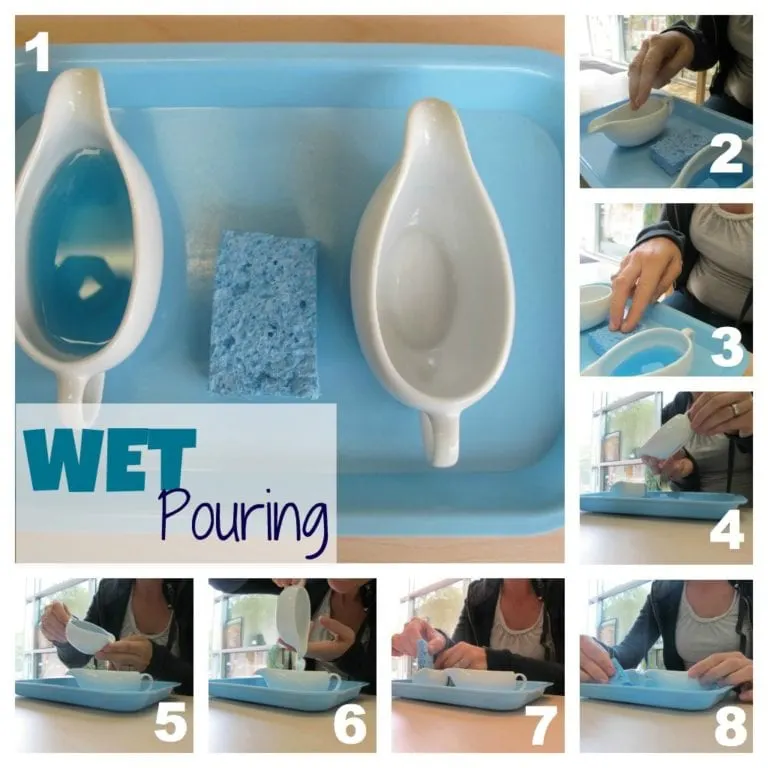
Practical Life Areas
Materials within practical life are natural because they are functioning, breakable, and resemble materials we see and use daily.
Montessori did not outline a specific set of Practical Life materials but instead created categories that included what she observed and believed to be the most relevant activities to a child’s life and development.
Montessori theory of practical life introduced areas including:
- Basic Procedures such as pouring, spooning, tweezing, basting, opening and closing containers, folding napkins
- Care of Self such as dressing (buttoning, tying, snapping, zippering), hand washing, putting on a coat, sewing, polishing, and food preparation
- Care of the Environment, such as table scrubbing, cloth washing, plant watering, and dusting
- Grace & Courtesy, such as demonstrating good manners with proper greetings and goodbyes, sitting, moving the body, and silence (inner calm & listening)
- Peace is based on three levels of learning and awareness: inner self, classroom, and globe.
The lead teacher is responsible for creating and arranging her works to be presented beautifully, neatly, and orderly on the shelves based on isolation of difficulty (simple to complex) and indirect preparation.
When the lead teacher is demonstrating an activity, she must use the “economy of words,” allowing the child to focus on her movements and not her words.
The child must grasp the work in a way that enables him to “teach” it to another person and in an authentic way in that he “owns” his version of the exercise.

Practical Life Materials
Practical Life materials contain a “control of error” that, once a child has been introduced to a particular work, will help to guide that child to self-correct and self-learn.
Therefore he has control over his education and his pace of development. He has the power to make choices within his work that will lead to success or failure.
He will quickly be able to learn to follow his instincts and interests.
The Montessori Theory focuses on teaching a child these activities and allowing him to participate in these everyday life activities gives him joy, builds self-worth, and develops confidence.
He feels the respect adults have for him and his ability to care for his environment, himself, and learning of the world.
Finally, once a child achieves inner discipline, confidence, and concentration, as demonstrated through completing an entire work cycle, the child is ready to move on to other materials within the Montessori classroom, such as the Sensorial materials.
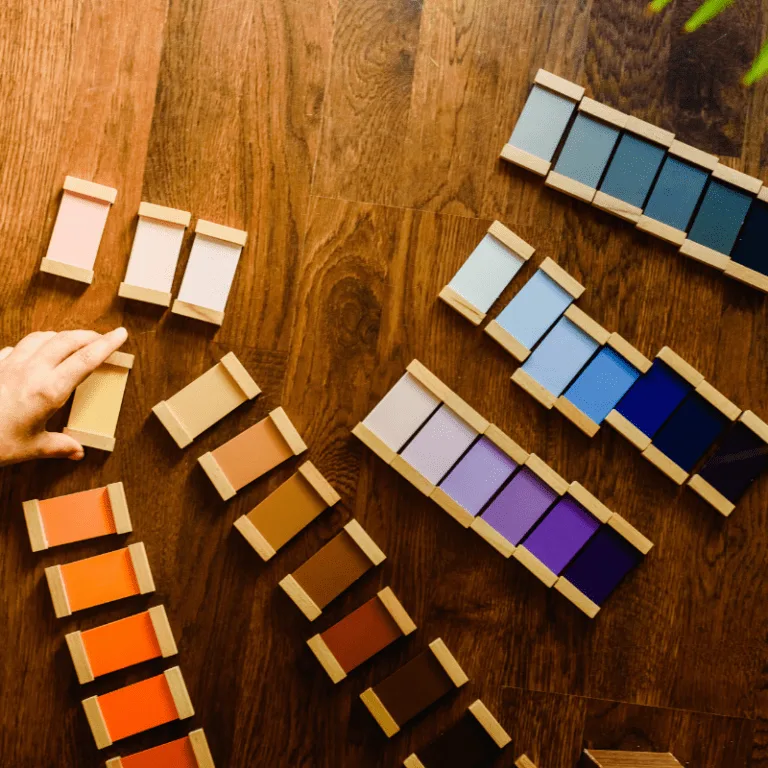
The Maria Montessori theory believed in the child’s ability to reach his potential on his own if given the freedom and the environment to develop naturally.
This respect Montessori bestowed on a child drew me to philosophy. She placed priority on the child and his natural development.
By believing in the child this way, she encourages and motivates children, teachers, and parents to help develop our children’s whole selves.
Children develop not only academic intelligence but emotional, social, and practical intelligence and less tangible skills, such as self-esteem, security, and confidence, required for a successful life.
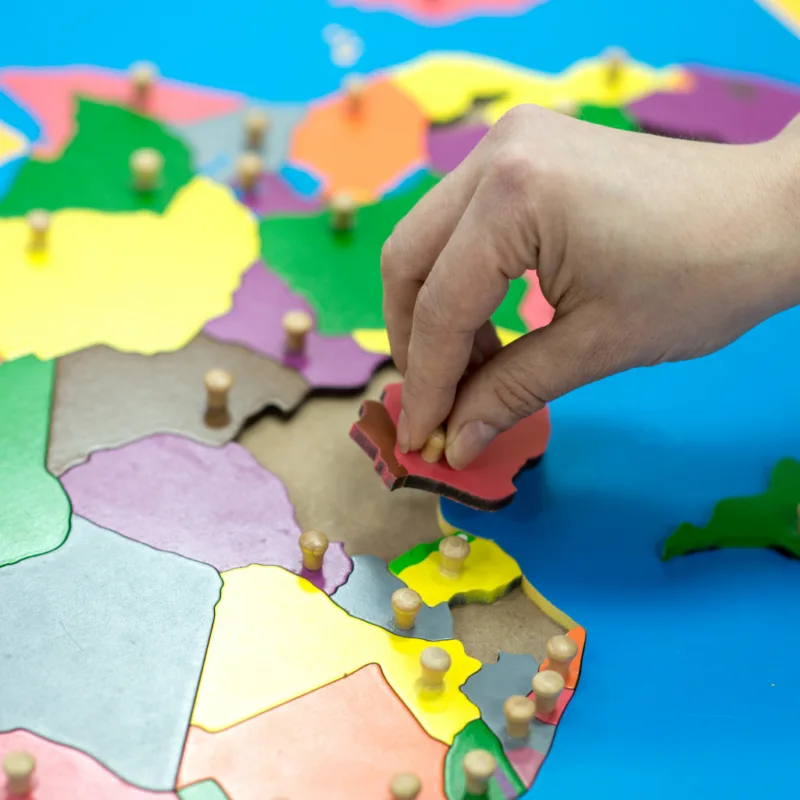
How fortunate are we that Maria Montessori developed a method of education to implement the Montessori theory? Montessori’s philosophy centers on the development of the whole child and depends significantly on the Teacher and a Prepared Environment.
Within a carefully prepared environment, the teacher’s main job is to observe the child as he moves about independently and with liberty in the classroom and to know when to intervene to guide the child.
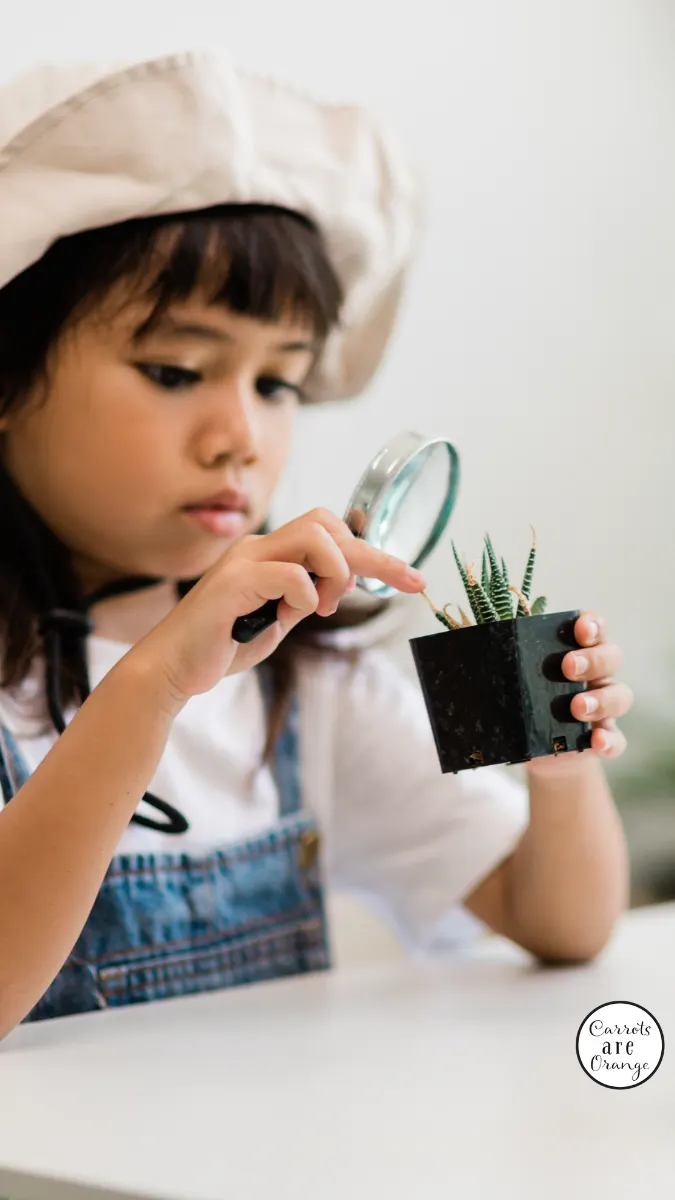
Our sensorial material provides a kind of guide to observation, for it classifies the impressions that each sense can receive: the colours, notes, noises, forms and sizes, touch-sensations, odors and tastes. This undoubtedly is also a form of culture, for it leads us to pay attention both to ourselves and to our surroundings. ~ The Absorbent Mind

The teacher and the assistant carefully prepare the classroom environment for children ages 2.5-6. The mixed-age classroom is a critical aspect of the Montessori method.
Children develop at different paces. Mixed-age classrooms also provide built-in peer-to-peer teaching and role models for younger children. Older children take on the responsibility of demonstrating to younger children their knowledge.
The materials are of high quality and ascetically pleasing to the eye. They are simple and neat. There is a great sense of order in the presentation of the materials on the shelf and in the layout of the classroom in designated areas for Practical Life, Sensorial, Culture, Geography, Maths, and so on.
Every material in the Montessori classroom contains a “control of error,” the ability for the child to self-correct and for the teacher to stand back to observe and then guide when necessary.
This self-correction leads the child to concentrate his attention upon the differences of dimension, and to compare the various pieces. {Montessori: A Modern Approach}

#2 – Sensorial
It is necessary to begin the education of the senses in the formative period if we wish to perfect this sense development with the education to follow. The education of the senses should be begun methodically in infancy, and should continue during the entire period of instruction to prepare the individual for life in society.
Montessori philosophy reads that educating the senses preceded intellectual development. A child’s education of the senses begins at birth. He takes impressions of his world through his senses.
Around 2.5 years old, he enters a sensitive period for organizing these impressions. Much like the alphabet organizes language, the sensorial work organizes these impressions.
…the function of the sensorial materials is not to present the child with new impressions (of size, shape, colour and so forth) but to bring order and system into the myriad impressions that he has already received and is still receiving.
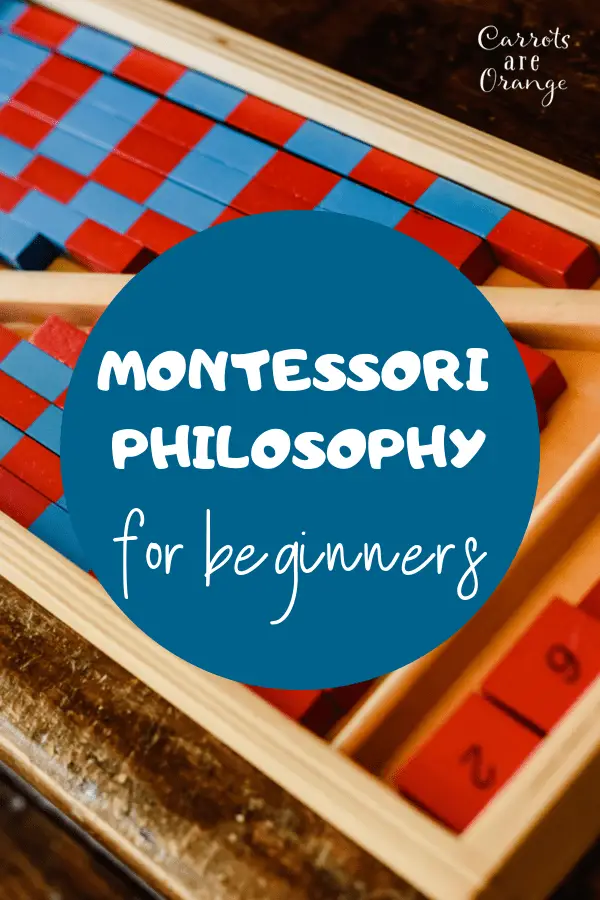
Sensorial Materials
Montessori created materials based on empirical observations of children. She carefully took each of the senses and thought about how best she could help the children to clarify and expand their existing experiences.
Montessori focused on “systems of objects that share a definite quality, such as color, shape, dimension.” She set forth with preparing the environment that provided the opportunity for a child to interact very precisely with a material or a “quality.”

Sensorial is one of five general curriculum areas within Montessori. The way it made the most sense to me during my training was to think of sensorial as one way the child (aka “the Young Explorer”) is trying to make sense of and study his environment (akin to language and the alphabet).
Using his senses, he classifies and creates order in his understanding, learning, and place in the world. The main goal is this sense of order through isolating specific concepts so that the child may acquire clear information and make sense of this information within his environment.
Sensorial Areas
Exercises are divided into the following areas with an example of material included:
- Visual – Broad Stair
- Olfactory – Smelling Bottles
- Gustatory – Tasting Bottles
- Tactile – Rough & Smooth Boards
- Visual (Geometry) – Triangle Box
- Auditory – Sound Cylinders
- Stereognostic – Mystery Bag
- Extensions
Each group of objects represents the same quality but to different degrees. Each material emphasizes one particular quality by eliminating or minimizing other differences.
So there is consequently a common but gradual distinction between the various objects and, when this is possible, one that is mathematically fixed, like the Pink Tower and the decimal system.
Sensorial Aims
Montessori sensorial aims include developing concentration, attention, or visual discrimination. Indirect purposes include math and reading & writing.
Works are completed left to right and top to bottom in preparation for these later skills to develop. Furthermore, new language such as “largest, smallest, heavier, rough, smooth….” is introduced throughout the work presentations.
Montessori introduced Isolation of Difficulty and Control of Error within these materials, two concepts paramount to Sensorial.
Each of these concepts gives the child control over the pace of his development and the opportunity to self-correct. Control of Error is automatic feedback that tells the child he needs to adjust to complete the work successfully.

No teacher needs to intervene in the learning process: “The goal is that the child will develop a sense of satisfaction from the work itself, not be dependent on the approval of a teacher.” [The Montessori Controversy, pg. 90] A child learns to make his own decisions and, therefore, to know and comprehend his instincts effectively.
He develops confidence and the ability to problem-solve. Montessori called children who reach this point “Normalized,” defined by qualities such as self-control, concentration, independence, empathy, and discipline. Normalization is the primary goal of Montessori education.
Every series of objects… is graded so that there is a maximum and a minimum, which determines its limits, or which, more properly, are fixed by the use which a child makes of them. ~ The Discovery of Childhood
#3 – Montessori Math
Humans are born with a propensity to be driven to calculate, reason, and create naturally. However, without guidance and nurturing within their environments, the capacity to perform such thinking is eventually lost.
A child’s experiences must lend to the innate mathematical mind to develop and function at the most significant capacity.
So, exposing a child to these concepts early in life is vital to developing more complex math concepts later. Without this exposure, his brain won’t be ripe for advanced learning and critical thinking.
In a sense, the brain will reject this type of thinking because it is not prepared to accept more complex information.

Dr. Montessori often emphasized the difference between children and adults. Adults focus on the product, while children focus on the process. This concept applies to Montessori Math.
Often difficult to observe and subsequently accept, especially by parents, the emphasis in a Montessori classroom is on the process.
The emphasis is not on the product of the child’s work. The development of the whole child is paramount to direct academic development. The latter is a by-product of the efforts to develop the whole child.
The focus is not on the answer – it’s on how your child gets the answer. This is contrary to the usual way we operate in the adult world, where results are the primary goal to be reached. ~ Michael Duffy, Math Works
Montessori Math Philosophy
Montessori promoted the belief that math in the early years prepares a child for logical and critical thinking. In other words, math is not for memorizing facts in a young child's developing mind.
In a young child’s life, math involves shapes, patterns, and spatial relationships within his environment. He absorbs these experiences into his brain, making it ripe for further developing and nurturing.
Current brain research indicates that learning patterns begin in utero. Babies in utero already begin to learn light and dark, day and night, tones and patterns of voices of people, music, and objects in the environment.
Music and exposure to languages other than a child’s native language are particularly beneficial to the child for these reasons.
As Montessori observed in her work, children are drawn to order. Thus, routines are critical for a child’s development. Routines give children an entrée into logical thinking.
Dr. Montessori did not have the luxury of modern medicine and research to support or explain her conclusions. Thankfully, current brain research now affirms Dr. Montessori's findings.
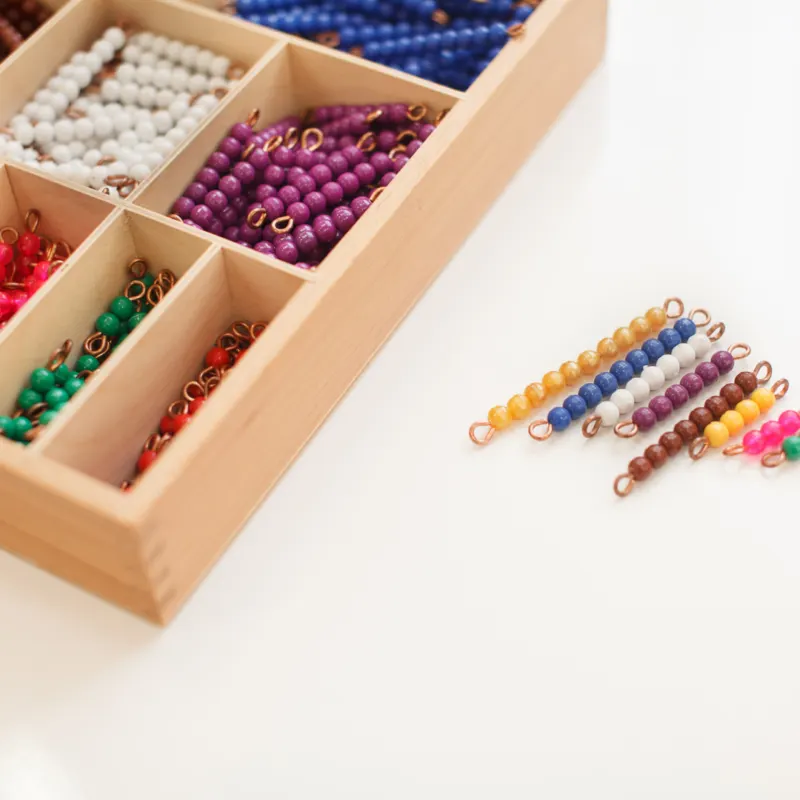
Montessori Math Materials
Montessori materials are multi-sensory and manipulative. This ensures that the child’s work with the materials simultaneously engages many brain parts.
The materials also connect the right and left parts of the brain. We can't say that the right side processes language and logic. Nor can we say that the left side leans towards spatial and creative ability. It is a group effort.
Not surprisingly, there is more to the left-brain/right-brain story. Current brain research indicates that the right hemisphere processes new information and challenges.
While the left hemisphere manages the information already familiar to us, Montessori materials, such as geometric shapes, actively connect the right and left sides of the brain.
Montessori Philosophy on Math & Brain Development
The right side handles the spatial intake. The left side controls the more abstract processing involved in using the materials. Both sides prepare the mind for later development.
Furthermore, the materials allow a child to self-correct. Therefore activating the part of a child’s brain responsible for the most advanced thinking, the frontal cortex.
The child is directly involved in the discovery process of finding an answer. No direction from an adult is required while using these materials. The child should be able to ascertain whether the conclusion is correct. In many cases, adjustments must be made to find the path to the “correct” answer.
This process is where neural growth occurs in a child’s developing brain.

#4 – Montessori Language
This section provides a Montessori Language introduction. Language permeates every area of the Montessori philosophy & learning environment. A child is born with what he needs to develop language. Of course, there are many ways we adults can enrich a young child’s language development.
We know that children will learn to speak as long as they are exposed to language early in development. On the other hand, the child must be taught reading and writing.
A child will learn the words that he is offered through his environment. {Enters the adult.} We have the power to prepare the environment for language development carefully. In other words, to make this environment rich and full of language learning opportunities.
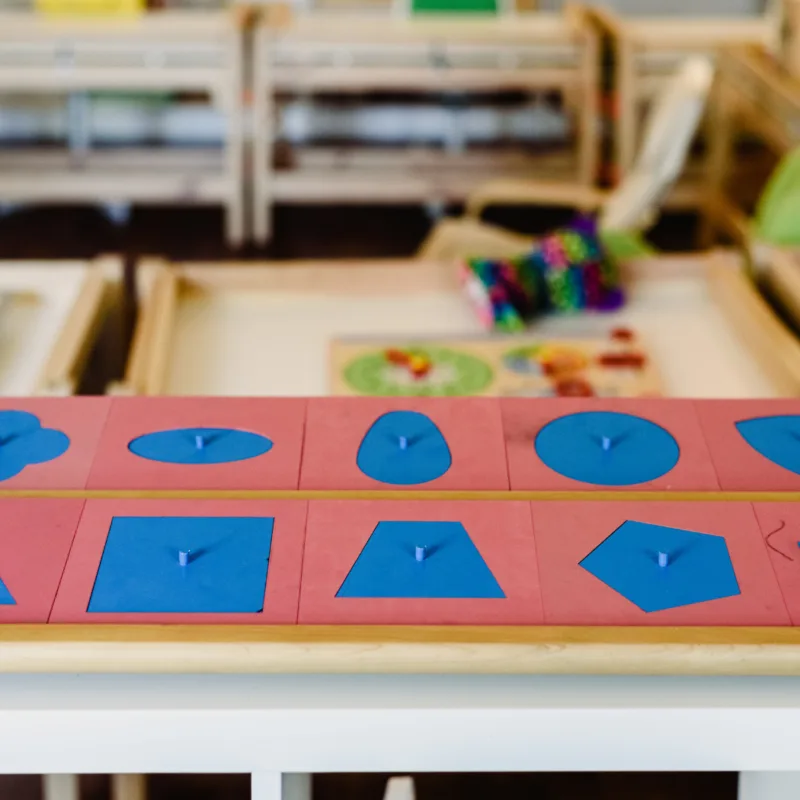
We know that a child absorbs language early in life with little effort. He creates an internal understanding of his environment. He must practice using these words during this time.
We can help by repeating words, speaking clearly, and using new words in complete sentences. The three-period lesson is beneficial during this time.
As phonetic awareness occurs, a child understands that letters and letter combinations have different sounds. At this point, the child is no longer absorbing effortlessly.
Now he must begin organizing what he absorbed during the first three years. The alphabet is one example of how a child organizes this learning.
Language Sequence of Lessons
Adults can help with songs, rhymes, and poems by tracking the words and sentences as we read books to them. Playing I-Spy with letters and sounds is also a great option.
Always encourage the child to sound out words by himself. As he becomes increasingly aware, he begins to understand that by putting together letters, we make words.
Montessori Philosophy – Preparation for Writing
Much of the work within an early childhood classroom is preparing a child to read and write, move from left to right, and fine motor skills.
Writing requires not only the brain to understand how certain letters and sounds come together to make words. They also develop fine motor skills and coordination to hold a pencil.
A moveable alphabet is a tool within Montessori that guides a child toward writing. With the moveable alphabet, he visibly creates words from letters. The work is “hands-on” so a child must use his hands and his language mind to create words. Sandpaper letters and a sand tray provide a similar experience.
{Read this post about ways to encourage a child with writing skills.}
How does Dr. Maria Montessori advocate teaching kids to read and write?
Unlike writing, where a child controls the language that he chooses to symbolize with letters. Language enriches any Montessori classroom environment (at home or outside the home). Reading presents a child with something a bit more abstract.
He must organize and place symbols on other people’s words. So a child first studies and then synthesizes when he reads. First readers like Bob’s Books and Miss Rhonda’s Readers are great tools to help a beginning reader.
#5 – Montessori Geography
Montessori geography is a beautiful piece of the Montessori environment. The focus is two-fold: 1) physical geography and 2) political geography. Political includes culture and anti-bias work and integrates with a peace curriculum Dr. Montessori created while in India.
The Montessori geography sequence is not as ingrained as the practical life, sensorial, math, and language sequences. You begin with a big-picture lesson with concrete nesting boxes, starting with the universe and moving to self.
The lesson sequence moves similarly from concrete to abstract, beginning with sandpaper globes. There is a lot of integration of the senses, just as in the other classroom areas.
An excellent resource for teaching geography is a guide by Tim Seldin called The World in the Palm of Her Hand.
Montessori Theory – Geography Sequence of Lessons
Download the Sequence of Lessons Now
For more on Montessori Geography, please check out The Ultimate Guide to Montessori Geography for Preschoolers.
More on Montessori Philosophy
- All You Need to Know About Montessori Art
- The Ultimate Guide to Teach History to a 3-Year-Old
- Montessori Theory: The Key Aspect of Movement
- 4 Reasons Your Child Embraces Repetition
- Thoughts on Pretend Play
- The Key Concept of Isolation in the Sensorial Area
- The Key Concept of Concrete to Abstract
- Montessori Versus Traditional Education: Why Montessori Wins
- Your Ultimate Guide to Montessori at Home
- Montessori Parenting


